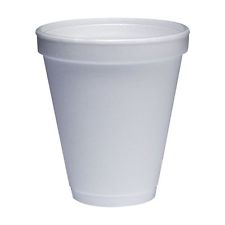The Dangerous-Sounding Threat of DHMO

Dihydrogen Monoxide, perhaps better known simply as “DHMO,” is a scary chemical compound. It’s fatal if inhaled in even relatively small amounts. It corrodes many metals. It’s a chief component of insecticides, acid rain, jet fuel, and even chemical weapons. DHMO-caused conditions are often associated with car accidents. In gaseous form, it’s been known to cause severe burns. And if you ingest it in solid or liquid form, eventually, you’ll die.
And — it’s everywhere. DHMO is commonly found in schools, and at times administered to children with only passing adult supervision. Many of us have pools of DHMO sitting idly in our backyards or communities. Our water supply is swimming in it. And, of course, DHMO is often present in that bane of the environment — the styrofoam drinking cup, pictured above.
Here’s what DHMO’s molecular diagram looks like:

Yes, that’s two hydrogens and one oxygen. Dihydrogren. Monoxide. Or, written differently, H2O. It’s just water — and nothing to worry about.
The DHMO prank has been around for a long, long time — so long, in fact, that most people reading this probably knew what was going on three paragraphs ago. But as Val St. John and Scott Fish learned the hard way in 2013, not everyone is in on the joke — and not everyone appreciates the humor.
St. John and Fish were, at the time, morning hours radio hosts for a Florida radio station. On April 1st of that year — and yes, that date should have been a clue — the duo decided to issue a public service announcement, telling listeners that dihydrogen monoxide was coming out of water taps in the area.
The reaction from what one would hope was a small, small minority of the listeners was fierce and nearly immediate. Enough people were fooled by the PSA that the county water board began fielding calls, and at 8:30 AM that day — about three-and-a-half hours into what should have been a five-hour radio show — St. John and Fish were taken off the air. The county issued a statement telling residents that the water was entirely safe and that this was just a joke gone bad (although without explaining the science), and the radio station, per the Atlantic, spent the rest of the day informing listeners of the same.
But beyond that, no big deal, right? Wrong — at least, according to the state’s Department of Health. Its spokesperson told the press that calling in “a false water quality issue” could be considered a felony in the state. The station, perhaps fearing liability, suspended the pair of DJs indefinitely. And listeners seemed OK with the punishment: according to USA Today, a (hardly scientific, but why should we get science involved here?) poll on the radio station’s website had a large majority — 77% — hoping that the two would never be welcomed back on the air.
Thankfully, cooler heads prevailed. The radio station revoked the suspension two days later and, per a follow-up report by the Atlantic, no criminal charges were to be brought against the duo. And people went back to drinking DHMO with reckless abandon once more.
Bonus fact: Another dihydrogen monoxide embarrassment? OK! See that styrofoam cup above? A lot of places have debated banning the cups because of the above-noted environmental concerns. But Aliso Viejo, California, almost had another reason: the cups are known to contain DHMO. In 2004, a city paralegal was doing some “research” online and came across the website dhmo.org, a tongue-in-cheek effort to warn people of the dangers of the compound also known as water. Unfortunately for Aliso Viejo, the paralegal didn’t get the joke and advised the city council to ban the cups, as DHMO is used in their production. A proposed ordinance banning styrofoam made its way onto the city council’s agenda but didn’t come up for a vote because, a week before it would have, someone noticed the error. But the press had a field day, embarrassing the city for its collective scientific illiteracy.
From the Archives: Allergic to Water: One of the first Now I Knows, which means it’s short. Even shorter: you can be allergic to water.
Related: DHMO, distilled.
